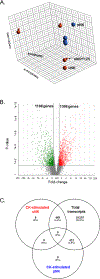Transcriptomic analysis of vitamin D responses in uterine and peripheral NK cells
- PMID: 31163399
- PMCID: PMC6885113
- DOI: 10.1530/REP-18-0509
Transcriptomic analysis of vitamin D responses in uterine and peripheral NK cells
Abstract
Vitamin D deficiency is prevalent in pregnant women and is associated with adverse pregnancy outcomes, in particular disorders of malplacentation. The active form of vitamin D, 1,25-dihydroxyvitamin D3 (1,25(OH)2D3), is a potent regulator of innate and adaptive immunity, but its immune effects during pregnancy remain poorly understood. During early gestation, the predominant immune cells in maternal decidua are uterine natural killer cells (uNK), but the responsivity of these cells to 1,25(OH)2D3 is unknown despite high levels of 1,25(OH)2D3 in decidua. Transcriptomic responses to 1,25(OH)2D3 were characterised in paired donor uNK and peripheral natural killer cells (pNK) following cytokine (CK) stimulation. RNA-seq analyses indicated 911 genes were differentially expressed in CK-stimulated uNK versus CK-stimulated pNK in the absence of 1,25(OH)2D3, with predominant differentially expressed pathways being associated with glycolysis and transforming growth factor β (TGFβ). RNA-seq also showed that the vitamin D receptor (VDR) and its heterodimer partner retinoid X receptor were differentially expressed in CK-stimulated uNK vs CK-stimulated pNK. Further analyses confirmed increased expression of VDR mRNA and protein, as well as VDR-RXR target in CK-stimulated uNK. RNA-seq analysis showed that in CK-stimulated pNK, 1,25(OH)2D3 induced 38 and suppressed 33 transcripts, whilst in CK-stimulated uNK 1,25(OH)2D3 induced 46 and suppressed 19 genes. However, multiple comparison analysis of transcriptomic data indicated that 1,25(OH)2D3 had no significant overall effect on gene expression in either CK-stimulated pNK or uNK. These data indicate that CK-stimulated uNK are transcriptionally distinct from pNK and, despite expressing abundant VDR, neither pNK nor uNK are sensitive targets for vitamin D.
Figures




References
-
- Abumaree MH, Chamley LW, Badri M & El-Muzaini MF 2012. Trophoblast debris modulates the expression of immune proteins in macrophages: a key to maternal tolerance of the fetal allograft? J Reprod Immunol 94 131–141. - PubMed
-
- Bulmer JN, Williams PJ & Lash GE 2010. Immune cells in the placental bed. Int J Dev Biol 54 281–294. - PubMed
Publication types
MeSH terms
Substances
Grants and funding
LinkOut - more resources
Full Text Sources
Research Materials

